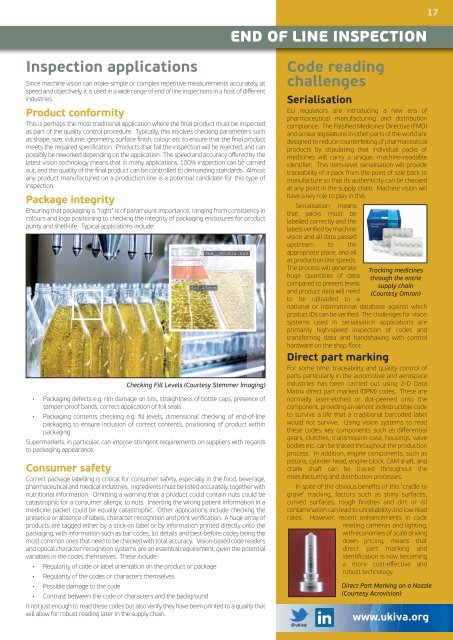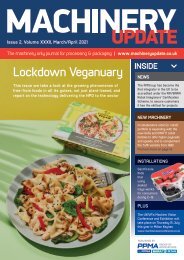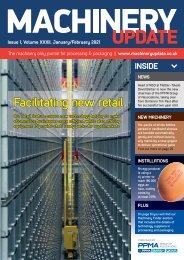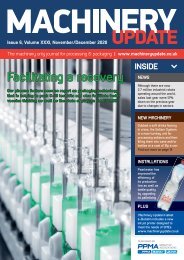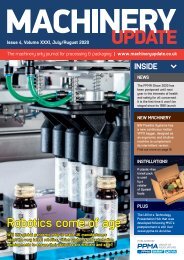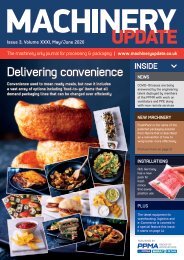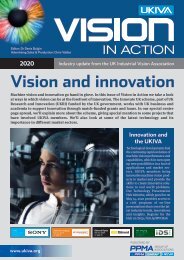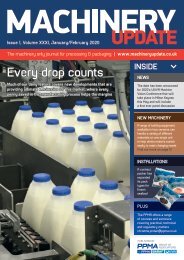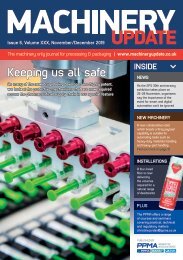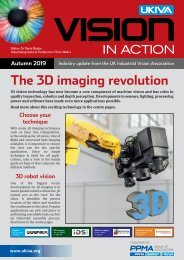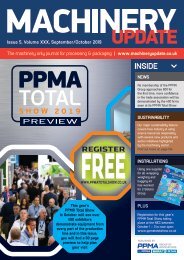Vision in Action - Autumn 2015
- No tags were found...
You also want an ePaper? Increase the reach of your titles
YUMPU automatically turns print PDFs into web optimized ePapers that Google loves.
17<br />
END OF LINE INSPECTION<br />
Inspection applications<br />
S<strong>in</strong>ce mach<strong>in</strong>e vision can make simple or complex repetitive measurements accurately, at<br />
speed and objectively, it is used <strong>in</strong> a wide range of end of l<strong>in</strong>e <strong>in</strong>spections <strong>in</strong> a host of different<br />
<strong>in</strong>dustries.<br />
Product conformity<br />
This is perhaps the most traditional application where the f<strong>in</strong>al product must be <strong>in</strong>spected<br />
as part of the quality control procedure. Typically, this <strong>in</strong>volves check<strong>in</strong>g parameters such<br />
as shape, size, volume, geometry, surface f<strong>in</strong>ish, colour etc to ensure that the f<strong>in</strong>al product<br />
meets the required specification. Products that fail the <strong>in</strong>spection will be rejected, and can<br />
possibly be reworked depend<strong>in</strong>g on the application. The speed and accuracy offered by the<br />
latest vision technology means that <strong>in</strong> many applications, 100% <strong>in</strong>spection can be carried<br />
out, and the quality of the f<strong>in</strong>al product can be controlled to demand<strong>in</strong>g standards. Almost<br />
any product manufactured on a production l<strong>in</strong>e is a potential candidate for this type of<br />
<strong>in</strong>spection.<br />
Package <strong>in</strong>tegrity<br />
Ensur<strong>in</strong>g that packag<strong>in</strong>g is “right” is of paramount importance, rang<strong>in</strong>g from consistency <strong>in</strong><br />
colours and logo position<strong>in</strong>g to check<strong>in</strong>g the <strong>in</strong>tegrity of packag<strong>in</strong>g enclosures for product<br />
purity and shelf-life. Typical applications <strong>in</strong>clude:<br />
Check<strong>in</strong>g Fill Levels (Courtesy Stemmer Imag<strong>in</strong>g)<br />
• Packag<strong>in</strong>g defects e.g. rim damage on t<strong>in</strong>s, straightness of bottle caps, presence of<br />
tamper-proof bands, correct application of foil seals<br />
• Packag<strong>in</strong>g contents check<strong>in</strong>g e.g. fill levels, dimensional check<strong>in</strong>g of end-of-l<strong>in</strong>e<br />
packag<strong>in</strong>g to ensure <strong>in</strong>clusion of correct contents, position<strong>in</strong>g of product with<strong>in</strong><br />
packag<strong>in</strong>g<br />
Supermarkets, <strong>in</strong> particular, can impose str<strong>in</strong>gent requirements on suppliers with regards<br />
to packag<strong>in</strong>g appearance.<br />
Consumer safety<br />
Correct package labell<strong>in</strong>g is critical for consumer safety, especially <strong>in</strong> the food, beverage,<br />
pharmaceutical and medical <strong>in</strong>dustries. Ingredients must be listed accurately, together with<br />
nutritional <strong>in</strong>formation. Omitt<strong>in</strong>g a warn<strong>in</strong>g that a product could conta<strong>in</strong> nuts could be<br />
catastrophic for a consumer allergic to nuts. Insert<strong>in</strong>g the wrong patient <strong>in</strong>formation <strong>in</strong> a<br />
medic<strong>in</strong>e packet could be equally catastrophic. Other applications <strong>in</strong>clude check<strong>in</strong>g the<br />
presence or absence of labels, character recognition and pr<strong>in</strong>t verification. A huge array of<br />
products are tagged either by a stick-on label or by <strong>in</strong>formation pr<strong>in</strong>ted directly onto the<br />
packag<strong>in</strong>g, with <strong>in</strong>formation such as bar codes, lot details and best-before codes be<strong>in</strong>g the<br />
most common ones that need to be checked with total accuracy. <strong>Vision</strong>-based code readers<br />
and optical character recognition systems are an essential requirement, given the potential<br />
variables <strong>in</strong> the codes themselves. These <strong>in</strong>clude:<br />
• Regularity of code or label orientation on the product or package<br />
• Regularity of the codes or characters themselves<br />
• Possible damage to the code<br />
• Contrast between the code or characters and the background<br />
It not just enough to read these codes but also verify they have been pr<strong>in</strong>ted to a quality that<br />
will allow for robust read<strong>in</strong>g later <strong>in</strong> the supply cha<strong>in</strong>.<br />
Code read<strong>in</strong>g<br />
challenges<br />
Serialisation<br />
EU regulators are <strong>in</strong>troduc<strong>in</strong>g a new era of<br />
pharmaceutical manufactur<strong>in</strong>g and distribution<br />
compliance. The Falsified Medic<strong>in</strong>es Directive (FMD)<br />
and similar legislations <strong>in</strong> other parts of the world are<br />
designed to reduce counterfeit<strong>in</strong>g of pharmaceutical<br />
products by stipulat<strong>in</strong>g that <strong>in</strong>dividual packs of<br />
medic<strong>in</strong>es will carry a unique, mach<strong>in</strong>e-readable<br />
identifier. This item-level serialisation will provide<br />
traceability of a pack from the po<strong>in</strong>t of sale back to<br />
manufacture so that its authenticity can be checked<br />
at any po<strong>in</strong>t <strong>in</strong> the supply cha<strong>in</strong>. Mach<strong>in</strong>e vision will<br />
have a key role to play <strong>in</strong> this.<br />
Serialisation means<br />
that packs must be<br />
labelled correctly and the<br />
labels verified by mach<strong>in</strong>e<br />
vision and all data passed<br />
upstream to the<br />
appropriate place, and all<br />
at production l<strong>in</strong>e speeds.<br />
The process will generate<br />
huge quantities of data<br />
compared to present levels<br />
and product data will need<br />
to be uploaded to a<br />
Track<strong>in</strong>g medic<strong>in</strong>es<br />
through the entrie<br />
supply cha<strong>in</strong><br />
(Courtesy Omron)<br />
national or <strong>in</strong>ternational database aga<strong>in</strong>st which<br />
product IDs can be verified. The challenges for vision<br />
systems used <strong>in</strong> serialisation applications are<br />
primarily high-speed <strong>in</strong>spection of codes and<br />
transferr<strong>in</strong>g data and handshak<strong>in</strong>g with control<br />
hardware on the shop floor.<br />
Direct part mark<strong>in</strong>g<br />
For some time, traceability and quality control of<br />
parts particularly <strong>in</strong> the automotive and aerospace<br />
<strong>in</strong>dustries has been carried out us<strong>in</strong>g 2-D Data<br />
Matrix direct part marked (DPM) codes. These are<br />
normally laser-etched or dot-peened onto the<br />
component, provid<strong>in</strong>g an almost <strong>in</strong>destructible code<br />
to survive a life that a traditional barcoded label<br />
would not survive. Us<strong>in</strong>g vision systems to read<br />
these codes, key components such as differential<br />
gears, clutches, transmission case, hous<strong>in</strong>gs, valve<br />
bodies etc. can be traced throughout the production<br />
process. In addition, eng<strong>in</strong>e components, such as<br />
pistons, cyl<strong>in</strong>der head, eng<strong>in</strong>e block, CAM shaſt, and<br />
crank shaſt can be traced throughout the<br />
manufactur<strong>in</strong>g and distribution processes.<br />
In spite of the obvious benefits of this ‘cradle to<br />
grave’ track<strong>in</strong>g, factors such as sh<strong>in</strong>y surfaces,<br />
curved surfaces, rough f<strong>in</strong>ishes and dirt or oil<br />
contam<strong>in</strong>ation can lead to unreliability and low read<br />
rates. However, recent enhancements <strong>in</strong> code<br />
read<strong>in</strong>g cameras and light<strong>in</strong>g,<br />
with economies of scale driv<strong>in</strong>g<br />
down pric<strong>in</strong>g, means that<br />
direct part mark<strong>in</strong>g and<br />
identification is now becom<strong>in</strong>g<br />
a more cost-effective and<br />
robust technology.<br />
Direct Part Mark<strong>in</strong>g on a Nozzle<br />
(Courtesy Acrovision)<br />
www.ukiva.org


